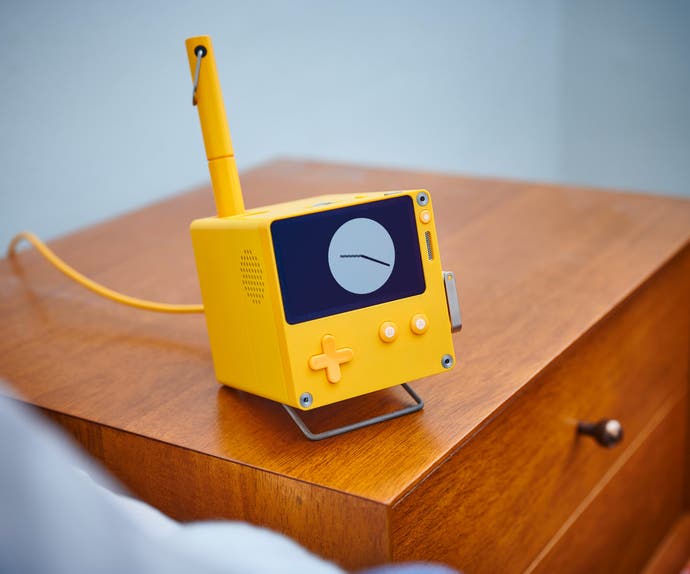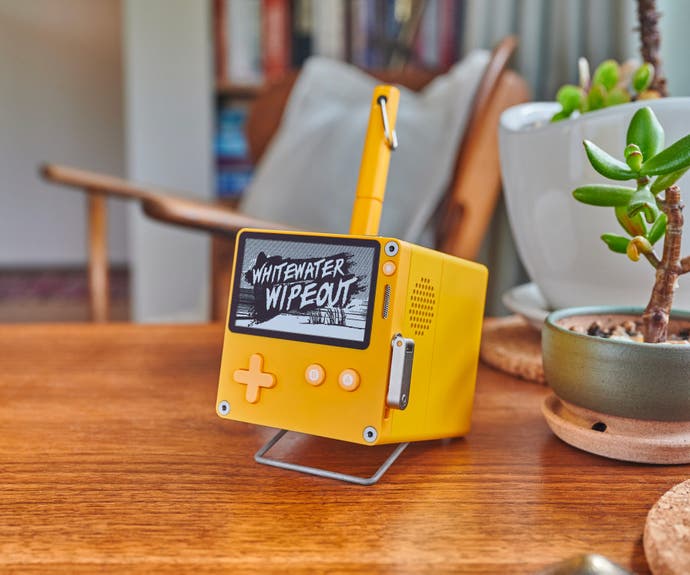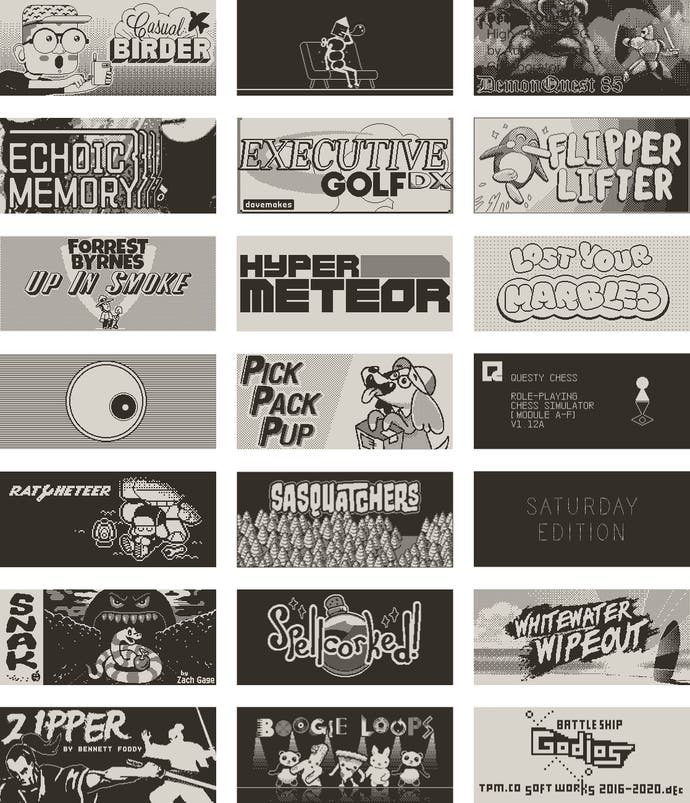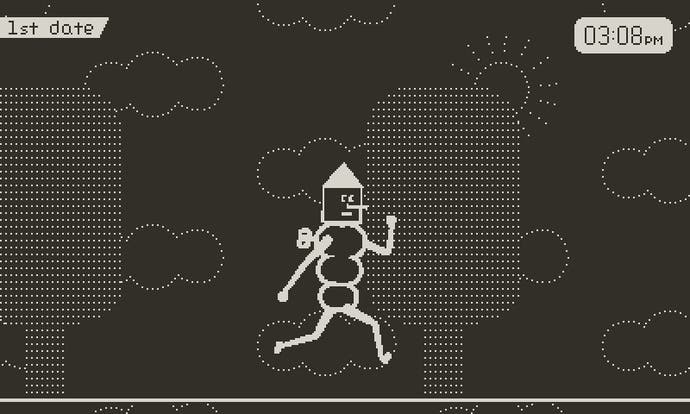Can the Playdate live up to its joyful premise?
Hands on with the pocket-sized, crank-based console.
I'd like to take a moment to talk to you about yolk. Yolk is objectively the best colour. There will be some amongst you who say this cannot be true, that taste is personal and so one colour, therefore, cannot "objectively" be better than another. Well, those people are objectively wrong.
Yolk is a dream, the colour of fried eggs, American cheese, rich and oh-so-saturated fat. If you paint your front door yolk I will for some reason assume you and your partner to be really good parents and just totally down to earth. This is the colour that improves burgers and perfects chips, that separates kindly bumblebees from harsh yellow wasps. The colour of friendliness, summer, warmth. The Playdate, of course, is yolk - not yellow - and so in many ways it has already won me over.
As you might already know, the premise with the Playdate is a little different to your usual handheld console. For $179 (the UK price is still yet to be announced - although we now know you can pre-order it from 6pm BST on July 29th), you get the console itself and 24 games, released two per week for its first 12 week "season" from launch. For a bit more - most prices are again still pending - you can get a smart little cover for the console, or a very snazzy dock that allows the Playdate to look pretty on your desk, and also holds a pen and plays the Poolsuite FM radio station. And the Playdate itself, of course, has a crank.
The crank doesn't charge the console or anything like that - it's another input, the Playdate's version of an analog stick, alongside a simple D-pad, the two A and B face buttons, a menu button and a lock one. There's a little speaker, a headphone jack, and a USB-C port for charging and presumably downloading the new games when they come out. And... that's it. Simplicity and charm are very much the point - the basic console is the simplicity, the crank and the colour and the branding the charm - which means they're also the source of everything that does and doesn't work with the Playdate so far.
At the moment, the charm is doing an awful lot of work. Handheld consoles have always relied more on their aesthetic, their vibe, a little more than home ones, because you carry these things around with you in the actual world, where actual other human beings might see you, and form opinions about you based on that weird thing you're holding. If I whipped out a PS Vita on the bus, for instance, people might think, "This man is clearly a genius." The Playdate, I think, suggests a judgement along the lines of "This man is playing a miniature, bright yellow console with a crank, because turning the crank reminds him of twizzling his moustache, or the whirring spokes of the penny farthing he rides to work at the Shoreditch Boxpark."


The point is there is more than a whiff of style over substance to the Playdate. In terms of simply using it, for instance, it is not the most comfortable thing in the world. You can tell that from looking at it because it's small and almost two-dimensionally thin. I was expecting as much and that's just fine, but the buttons themselves aren't actually very comfortable. Both the D-pad and face buttons are solid plastic and there's an oddly firm click to pressing them, which means games that have lots of dialogue text or require you to press A repeatedly, like point-and-click-style adventure Saturday Edition, get mildly uncomfortable, quite fast. It's minor but it is noticeable - the actual A and B of my A and B buttons were also, I think, just ever so slightly printed off-centre, as well, which I think annoyed me more than them being uncomfortable to press because this console is all about being a delight to look at, above all, and little imperfections like that can grate. At the same time, although this is the "final hardware" version of the Playdate it is still a pre-release one, so some benefit of the doubt should be reserved for this sort of thing.
There's also a slight creakiness to it, especially near the top of the console. The body is entirely plastic, which surprised me - I was expecting some kind of metal, given the premium pitching of it - and that makes it feel incredibly light. It's an odd thing to dislike in a handheld, as most of the time you obviously want them to be as light as possible to carry around, but there's a difference between light, and lightweight, and the Playdate leans slightly towards the latter. All of these are small things of course, too. Build quality is by no means bad - it works well and nothing feels like it's going to break, despite some games being quite demanding on the old crank - just, maybe not as spot-on as you might have expected.

What I didn't find as frustrating as others might, too, was the screen. Playdate sports a 400x240 1-bit display, and it's utterly gorgeous. The effects that developers have managed to get from it are quite stunning, all pointillist backgrounds and hazy wipes. It's pinprick sharp, and the blacks and gameboy silver-green-grey background just sings next to the lovely sweet yolk of the console itself. I adore it. The problems some might have will be the lack of a backlight (gasp!) but unless you plan on playing it in your home in the dead of night with all the lights turned off, or maybe in the middle of some rural farmland, I can't see where that'd be much of a problem. In fairness, maybe the back of the car, if you're a child or a millennial still clinging to hope of time-travel back to the '90s, but otherwise, I had no issues with it - the weird, metallic reflectiveness to it is just part of the charm, a nostalgia play that honestly works just fine for me.
The thing that makes and breaks consoles, though - stylish accessories or not - is the games. I have reservations about Playdate's. The preview unit I've had for the last week or so came with four games installed, all of them in non-final condition, although one or two minor, ignorable bugs with Saturday Edition aside they seemed perfectly polished. Saturday Edition was by far the best, a surprisingly gripping mystery about a man abducted by aliens who, years later, gets wrapped up in their much more public return to earth. It's a cracking little story, probably six-ish hours long, and it doesn't use the crank. It could be anywhere, but it's on the Playdate, and in a way that's the perfect advert for it - there are good developers releasing good games, here and here alone.




On the other hand, the other three underwhelmed. Crankin's Time Travel Adventure is a kind of horizontal runner game from uvula, the micro studio led by Keita Takahashi, of Katamari Damacy fame, along with Ryan Mohler, Matthew Grimm and Shaun Inman. The premise is that you are a stick figure man who's late for a date, turning the crank one way moves you forward, turning the other way moves you backwards, but you'll need to move forward and backward at precise moments in time to avoid obstacles that are coming at you whatever way the crank turns. It's a neat idea for a couple of minutes but after that, it does get old pretty fast. It's a runner game but you turn the crank to run, that's it.
Whitewater Wipeout, by Chuhai Labs, is a bit more like it, a score-based surfing game where the crank controls your direction and momentum, and it's enjoyable as a kind of pick-up-and-fiddle-with-something distraction from work, but again, the longevity beyond a few goes is debatable. It's oddly addictive like any good high-score game, and some people will get a kick out of global leaderboards, but how many is another question.

Finally there's Lost Your Marbles, which features a 16-bit town of quirky characters and overlong, sometimes funny and sometimes slightly grating dialogue, that features minigames within it where you turn the crank to tilt the screen, moving a marble around it. The problems are twofold there, in that tilting the screen rapidly back and forth, while holding the actual console still, bestows upon you some pretty rotten motion sickness, so I often had to stop playing. And also in that again as far as games go it is incredibly simple - I have a pair of cufflinks with little football pitches on them that work in the same way: tilt to get the ball-bearing into the hole.
What it comes back to with the Playdate, then, is charm, and there are buckets of it here, in the console and in the few games I've played so far. I love the look of this thing, I love the mood of it, the joy, the whole idea that's all about getting games in people's hands, about giving designers some restrictions to jump off and spin into a thing of their own. And there are wonderful designers waiting to do exactly that, Lucas Pope, who made Papers Please and the stunning Return of the Obra Dinn, stands out in particular. But, for now, there are still some questions about whether the great ideas of the Playdate can really come together.






.png?width=291&height=164&fit=crop&quality=80&format=jpg&auto=webp)



